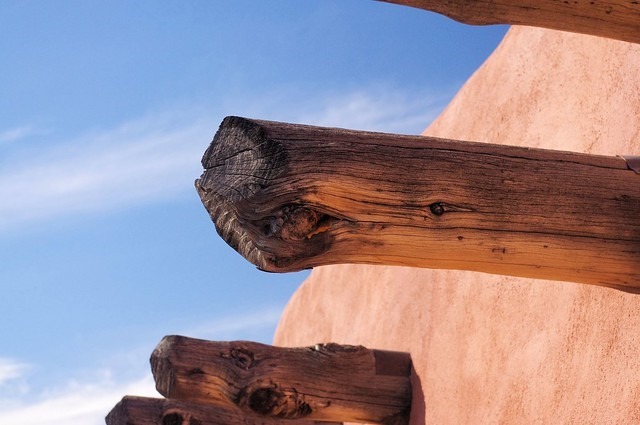Royalty-free images by Mike1 — No. 86 of over 1200 images

Painted Desert Inn Viga, Petrified Forest National Park, Arizona, October 9, 2011
Viga2
Vigas are wooden beams used in the traditional adobe architecture of the American Southwest, especially New Mexico. In this type of construction, the vigas are the main structural members carrying the weight of the roof to the load-bearing exterior walls. The exposed beam ends projecting from the outside of the wall are a defining characteristic of Pueblo architecture and Spanish Colonial architecture in New Mexico and often replicated in modern Pueblo Revival architecture. Usually the vigas are simply peeled logs with a minimum of woodworking. In traditional buildings, the vigas support latillas (laths) which are placed crosswise and upon which the adobe roof is laid, often with intermediate layers of brush or soil. The latillas may be hewn boards, or in more rustic buildings, simply peeled branches. These building techniques date back to the Ancestral Puebloan peoples, and vigas (or holes left where the vigas have deteriorated) are visible in many of their surviving buildings.
Since the modern Pueblo Revival style was popularized in the 1920s and 1930s, vigas are typically used for ornamental rather than structural purposes. Noted architect John Gaw Meem incorporated ornamental vigas into many of his designs. Contemporary construction in Santa Fe, New Mexico, which is controlled by stringent building codes, typically incorporates ornamental vigas, although the latest revision of the residential building code gives credit for structural vigas. Older structures that have been reconstructed (e.g. the Palace of the Governors in Santa Fe) may contain both structural and ornamental vigas.
- I am sharing some of my public domain images in periodic blog posts.
- Wikipedia
Notes:
- This image is also shared as public domain on Pixabay and Flickr.
- Images are being shared in the sequence they were accepted by Pixabay, a royalty-free image sharing site.
- Only images specifically identified as such are public domain or creative commons on our pages.
- All other images are copyright protected by me, creative commons, or used under the provisions of fair use.

